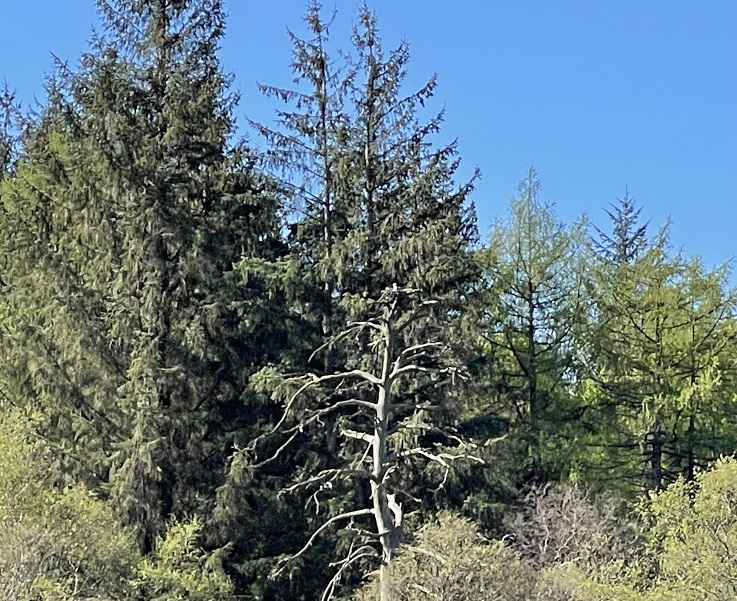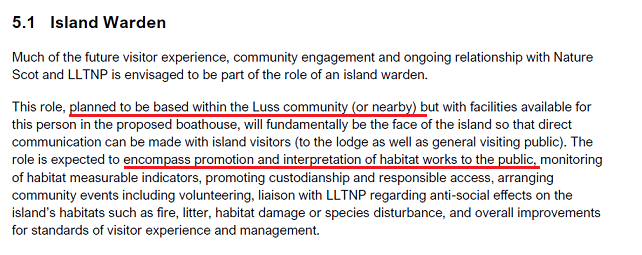On 10th December 2021, Mrs and Mr Jones – Kirsty Young and her husband – submitted a planning application (see here) to build a luxury lodge on the north shore of Inchconnachan, the island on Loch Lomond they had bought from Luss Estates. The application included proposals to restore native woodland and manage visitors on the island which is a Special Area of Conservation. After a flurry of publicity and comments on the planning application in the early part of last year, the last document to be uploaded on the planning portal (see here) was on 20th April. That is now almost seven and a half months ago for a planning application whose target decision date was 20th February.
The target timescales for determining planning applications, however, are completely unrealistic and should not be used to judge the “performance” of planning authorities. Developers have pushed the Scottish Government into agreeing short timescales to promote their own interests and not those of the public. But when Planning Authorities rightly start engaging with developers about their proposals – which one assumes is what is happening in this case – there needs to be transparency about what is going on.
Last month the Loch Lomond and Trossachs National Park Authority (LLTNPA) published their letter to Flamingo Land clarifying what further information and what issues needed to be addressed before they could decide that planning application (see here). That was very welcome but begs the question why have the LLTNPA not also done this at Inchconnachan where there are similar levels of public concern?
Conservation and wildlife on Inchconnachan
In a post in February I raised a number of questions about how the LLTNPA and the planning system more generally is responding to development proposals in Special Areas of Conservation, including Inchconnachan (see here). Planning authorities, including our National Parks, have not been helped on this by NatureScot. They have been all over the place in their approach to SACs, whether this is failing to protect them at Drumochter (see here) or killing beech trees on the neighbouring island of Inchtavannach on the grounds they were not native (see here). (Beech are native to the British Isles but first arrived in Scotland by humans planting them rather than natural seeding).
On Inchconnachan NatureScot apparently advised Mr and Mrs Jones that the wallabies on the island were a threat to the oak woods, hence why they included a proposal to remove them in the planning application. That resulted in a predictable storm of protest: 100,000 signatures by July (see here), almost twice the number of people who lodged objections against the original Flamingo Land proposal. While these signatories might not officially have been lodged as objections to the current application, no planning authority or politician can afford to ignore this level of protest.
A simple solution would have been for Mr and Mrs Jones to have dropped this element of their management plan for the island. That they haven’t suggests that NatureScot is holding out and, as the body primarily responsible for SACs, refusing to approve any management plan that does not include the removal of the wallabies. This could explain the delays.
The irony is that the wallabies appear to have been gradually dying out anyway (the in-breeding won’t help). Just seven were recorded at the start of the current Loch Lomond Islands Deer Management Plan 2019-24 (see here). Wallabies are small animals and one wonders whether the damage they do is significant compared to the numbers of fallow deer on the islands?
The other conservation issue that may be delaying the application are the osprey that nest on the site of the proposed luxury lodge. The ecology report accompanying the planning application referred to “past use” of the island by ospreys – a misrepresentation of the truth. Luss and Arden Community Council, in their excellent response to the application, corrected this stating that they believed there was an “osprey nest within the curtilage of the proposed lodge”. The osprey were back again in April:

Strangely, the RSPB did not mention the nesting osprey in their response to the planning application (see here) so I wrote to them as a member of the RSPB questioning why they had not done this. After a number of emails had been exchanged, as far as I could ascertain they were negotiating with the LLTNPA behind the scenes but just to what end what unclear. It is highly regrettable that organisations like RSPB do not see the need for more transparency. Perhaps, however, their intervention explains why the application appears to have stalled?
The visitor management proposals for Inchconnachan
The other issue that might have put a spanner in the planning application is the Scottish Environment Protection Agency’s objection to the creation of accommodation for a warden above the boathouse. This was on the grounds of flood risk and, as the Friends of Loch Lomond and Trossachs pointed out in their response, appears to be another case of a public agency losing sight of what is important. Could there be any accommodation in Scotland better placed to cope with flooding a building constructed above a boat house and for a warden an integral part of whose job includes using those boats?
Whether or not the LLTNPA is able to resolve these issues remains to be seen. But if the boat house accommodation goes, the warden will need a base. And where better than the former visitor centre at Luss which the LLTNPA Board agreed that staff could sell off in September (see here)?
The challenges at Inchconnachan, where one of the derelict buildings was set on fire in May (see here), proves what Board Member Ronnie Erskine argued at the meeting: that the LLTNPA should have developed their proposed West Loch Lomond Visitor Management Plan before deciding to sell off publicly owned assets there. Not a single member of the LLTNPA senior management team, however, mentioned in that discussion what was going on at Inchconnachan or the implications for Luss:

It is unlikely that any member of the LLTNPA Board was aware of the issues or able to challenge staff because effectively they are excluded from almost all planning matters. All meetings of the Planning Committee between June and December were cancelled – due to “lack of business” – and in any case when meetings do occur matters like updates on planning application are never on the agenda. It says something when the LLTNPA Board is almost as certainly as much in the dark about what is going on at Inchconnachan as the general public.
The wider failure of the LLTNPA here has been to take a strategic look at visitor management across the larger and most frequented islands off Luss and the area of loch in between and what this would cost. Instead, it has been taking a piecemeal approach in which there is no place for public investment. Hence, the initial welcome for Kirsty Young’s proposals (visitor management paid for by a luxury lodge). Hence too the proposals being considered as part of the Loch Lomond byelaws which would impose further restrictions on boating when the LLTNPA is not even enforcing the existing byelaws (e.g powerboats speeding by paddle boarders in Luss bay has been an issues for some time).
Luss and the abandoned Visitor Centre building could play a central role in helping to address these issues, for example:
- as an additional base for the water rangers (Balloch is far to far away to be effective)
- as somewhere for interpreting and educating the public about the natural history of the area (as proposed in the Inchconnachan island warden job description)
- as a base for helping manage the 700,000 plus people who visit Luss each year (including for the police at peak periods)
- as a base/store for equipment (the planning application states that Mr and Mrs Jones have secured a store/base further south at Bandry Bay).
What needs to happen
The LLTNPA Board should not lose the opportunity to take a more holistic look at the management of both nature and people along the west shore of Loch Lomond and its islands. They should be instructing staff to work in partnership with the Luss Community Development Trust, the owners of the islands (including Mr and Mrs Jones) and recreational interests to develop a plan to do so. Until that is developed and agreed the LLTNPA should d put on hold any actions to sell off the Luss Visitor Centre.
The LLTNPA Board should also be asking staff to report only on their negotiations about the development of the proposed luxury lodge on Inchconnachan. In my view there is a simple solution to reduce the impact on the Special Area of Conservation and protect the nesting osprey, move the proposals for the lodge to the site of the original buildings which had previously been granted consent by the LLTNPA for redevelopment. A lodge in that position might not attract so many high paying visitors but it would resolve most of the issues and if some public investment was then needed to assist with restoring nature on the island so be it.
As for the wallabies, they should be left for the time-being. A far more important priority – which has been delayed a year by the planning application stalling – is to get on with the removal of the sitka spruce whose number, unlike the wallaby, have been increasing year by year.
Merry Christmas!
If the Wallabies are dying out it is because it was reported by locals that several years ago in the dead of winter a cull was carried out with the intention of eradicating them. Obviously it was done incompetently, how unusual.
I wouldn’t necessarily believe the survey saying there are very few left however, such surveys usually don’t stand scrutiny and this case is no exception – large areas of the interior of the island are effectively impenetrable to humans.
Every consultation mentioning the Wallabies shows a clear desire among the public that they should be left alone but LLTPA wants them gone and as we know they do what they want.
Years ago pre cull I sat with a group on the beach on Inchconnchan one Autumn evening at dusk when two Wallabies came down to the shore to drink, it was a magical moment, naturally something that LLTPA want to destroy in favour of some managed and manufactured “visitor experience”.
As at least one of the areas buoyed off with threats of draconian prosecution is a traditional anchorage where the reason given is an Osprey nest (which was established before the restrictions so clearly the Ospreys don’t care about the boats), it is interesting to see that their presence is not apparently an obstacle to this development.
What a wonderful opportunity Scotland had for turisom and now lost with the culling of the Wallibes and now their removing them completely If a bit of planning was used a tea room some mooring in place boats coming from Balmaha and Luss selling cabbages etc if this was the Lake District it would have been in place a long time ago Be carfull the tree the Ospreys nest in is not cut down the old building has already been burned down Scotland is so backward Loch Lomond was ment for the people of Glasgow to enjoy yet kidds can’t even go camping their The LLTNPA is not fit for purpose more than happy to take boaters money but not happy to put lighting at Duncan’s Slipway
Surprised there are still any wallabies left, after the park authority virtually advertised in the press their whereabouts and how to get there and kill them, resulting in a photo of a wallaby tied to a tree and set on fire. I noticed that the tree the osprey was nesting in was a nonnative species and therefore must be destroyed as part of the LLTNPA drive for ecological correctness.